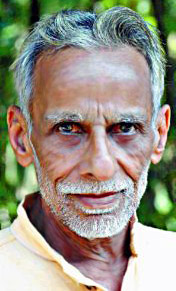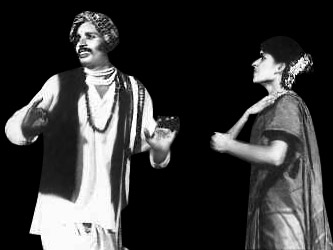 Ninasam is the acronym for Sri Nilakantheswara Natyaseva Sangha. Ninasam began in 1949 as a rural amateur theatre group at Heggodu, near Sagar in Shimoga district, Karnataka. This was founded by K. V. Subbanna`s father.
Ninasam is the acronym for Sri Nilakantheswara Natyaseva Sangha. Ninasam began in 1949 as a rural amateur theatre group at Heggodu, near Sagar in Shimoga district, Karnataka. This was founded by K. V. Subbanna`s father.
Producing plays regularly under Subbanna, it branched out into varied activities and projects during the 1970s. In 1973, it started a film society called Chitrasamaj, which expanded further in 1983-85 with formal courses. In 1980, it set up the Ninasam Theatre Institute to train young enthusiasts in acting, lighting, and directing through an annual ten-month Theatre Arts Diploma Course for about twenty selected students. So far, it has produced over 200 graduates, absorbed by theatre troupes in Karnataka like Rangayana and Kinnara Mela. Ninasam has done its bit to hasten the process of decentralization and professionalism in Kannada theatre. Ninasam Tirugata, an itinerant repertory, was established in 1985. By the end of the century, the institute and repertory had staged about 100 major productions and about 180 experimental productions, of not just Kannada plays but translated Indian and European classics too.
In 1989, the Ninasam Culture Course was begun to instruct people through interdisciplinary lectures on film, theatre, music, literature, and the visual arts. In 1991-3, Ninasam undertook a theatre-in-education  project, Shalaranga, to create cultural awareness among schoolchildren with a series of workshops in theatre and allied arts. Subbanna established the Ninasam Pratishthana or Ninasam Foundation in 1992, to conduct short-term literature appreciation courses in smaller towns of Karnataka. Ninasam`s infrastructural facilities include a library and the Shivarama Karanth Rangamandira, the first fully equipped auditorium in rural Karnataka. Its resourcefulness made Ninasam a cultural ashram for art lovers and its influence galvanized the aesthetic life of Karnataka.
project, Shalaranga, to create cultural awareness among schoolchildren with a series of workshops in theatre and allied arts. Subbanna established the Ninasam Pratishthana or Ninasam Foundation in 1992, to conduct short-term literature appreciation courses in smaller towns of Karnataka. Ninasam`s infrastructural facilities include a library and the Shivarama Karanth Rangamandira, the first fully equipped auditorium in rural Karnataka. Its resourcefulness made Ninasam a cultural ashram for art lovers and its influence galvanized the aesthetic life of Karnataka.
This article is a stub. You can enrich by adding more information to it. Send your Write Up to content@indianetzone.com




















